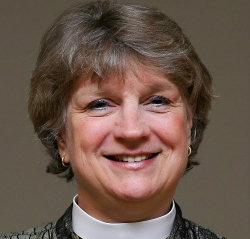The signs are already here
December 2nd, 2019 By Bishop Ann Svennungsen
By Bishop Ann Svennungsen
Keep awake, therefore, for you do not know on what day your Lord is coming.
During my last year of seminary, I had an 8:00 a.m. class on the Gospel of John. I was also three months pregnant – a bad combination for wakefulness. I’ve kept my notes from that class. For a few pages, they’re clear and coherent. But, after a while they start to make little sense – kind of dreamlike stream of consciousness. Then the writing just stops as the ink drops off the page. Clearly, I’ve fallen asleep.
“What does Jesus mean when he tells the disciples to stay awake?”
What does Jesus mean when he tells the disciples to stay awake? It’s not about attentively trying to calculate a timetable for Jesus’ return. Jesus doesn’t even know this.
But Jesus provides some hints in the next chapters of Matthew’s Gospel. He tells four stories, all about attentiveness. Tenants are left to steward the landowner’s property. Some do well; others don’t. Bridesmaids attend a wedding – five prepare, five don’t. When the party finally begins, five missed the whole thing because they had to go buy more oil.
THE FINAL STORY IS the most vivid of all. Now, the one who returns isn’t the master in some parable, it’s the Son of Man, with all the nations gathered before him. And, if you wonder who’s stayed awake, who’s been alert in the time before the Lord’s returned, you get this answer: “You were awake if you fed the hungry, gave drink to the thirsty, welcomed the stranger, clothed the naked, cared for the sick, visited the prisoner.” And, what is more, when you were awake and doing those things, you were not only doing them for the person suffering, you were doing them for Jesus himself.
“Being awake doesn’t mean trying to figure out when Jesus will return.”
Stay awake. Keep alert. Be alive and responsive to the needs of this world, this broken but God-so-loved world.
Being awake doesn’t mean trying to figure out when Jesus will return. Being awake means loving the neighbor. It means stewarding the gifts God has given us. It means using our talents and lighting our lamps and doing our jobs so that God’s love is made known in thousands of ways – large and small. And how much more exciting is that than watching the skies and looking for signs?



 By Bishop Ann Svennungsen
By Bishop Ann Svennungsen  By Bishop Ann Svennungsen
By Bishop Ann Svennungsen